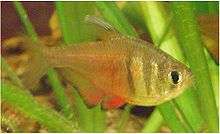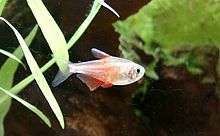Flame tetra
The flame tetra (Hyphessobrycon flammeus), also known as the red tetra or Rio tetra, is a small freshwater fish of the characin family Characidae. This tetra was first introduced as aquarium fish in 1920 by C. Bruening, Hamburg, Germany, and formally described in 1924 by Dr. George S. Myers.[1][2] Today large numbers are bred in captivity and it is common in the aquarium trade,[3] but the remaining wild population in Southeast Brazil is highly threatened.[4][5]
| Flame tetra | |
|---|---|
 | |
| Flame tetra (male) | |
| Scientific classification | |
| Kingdom: | Animalia |
| Phylum: | Chordata |
| Class: | Actinopterygii |
| Order: | Characiformes |
| Family: | Characidae |
| Genus: | Hyphessobrycon |
| Species: | H. flammeus |
| Binomial name | |
| Hyphessobrycon flammeus Myers, 1924 | |
Cuba produced a postal stamp with an image of H. flammeus in 1978.[6]
Description
The flame tetra reaches about 2.5 cm (1 in) in standard length.[4][5][7] The rear half of the body is flame red while the area in front of the dorsal fin is silver crossed by two dark vertical bars. All the fins are red except for the pectoral fins, which are colourless. The tip of the anal fin on the male is black, while on the female the fins have less red colouration but darker tips of the pectoral fins.
Distribution, habitat and status
The flame tetra is native to Southeast Brazil, where it occurs in coastal parts of Rio de Janeiro (Guanabara bay region, and Paraíba do Sul and Guandu River basins) and São Paulo (upper Tietê River basin).[4][5] It lives in rivers and streams, generally preferring shallow (less than 0.5 m or 1.6 ft deep), slow-flowing sections with vegetation and a water temperature from 22 to 28 °C (72–82 °F).[4]
The species has declined drastically, mainly because of habitat loss, pollution and introduced species (especially tilapia and black bass).[4][5] Although sometimes reported as extinct in the wild,[7] wild populations survive.[4][5] In its small remaining distribution, it is common in the Tietê River basin (which possibly is not natural, but introduced) and rare elsewhere.[4] The last confirmed record from Rio de Janeiro is from 1992.[5] The species is listed as endangered in the Brazilian national red list.[8]

Today large numbers are bred in captivity and it is common in the aquarium trade.[3][5] This includes some selectively-bred forms (such as golden, orange and albino) that differ from the original wild form.[5]
Aquarium keeping and captive breeding
H. flammeus is a peaceful schooling fish, and will generally do well in groups. H. flammeus has an omnivorous diet.[7] The species will breed in captivity.[7]
References
- Myers, G.S. 1924. A new characin fish from Rio de Janeiro. – The Fish Culturist, 4: 330–331.
- Type series of 2 specimens, United States National Museum of Natural History, Smithsonian Institution, Washington D.C., catalog number USNM 92969 (includes both specimens), see Vari, R.P. and Howe, J.C. 1991. Catalog of type specimens of Recent fishes in the National Museum of Natural History, Smithsonian Institution. 1. Characiformes (Teleostei, Ostariophysi). – Smithsonian Contributions in Zoology, 517: 1–52.
- Aquainfo: Breeding Hyphessobrycon flammeus. Retrieved 21 March 2017.
- Carvalho, F.R., Jesus, G.C.d. & Langeani, F. (2014). Redescription of Hyphessobrycon flammeus Myers, 1924 (Ostariophysi: Characidae), a threatened species from Brazil. Neotropical Ichthyology, 12 (2): 247-256.
- SeriouslyFish: Hyphessobrycon flammeus. Retrieved 21 March 2017.
- See image here, from: Froese, R. and Pauly, D. (eds.) 2007. FishBase. – WorldWideWeb electronic publication, www.fishbase.org, version 11/2007.
- Froese, Rainer and Pauly, Daniel, eds. (2017). "Hyphessobrycon flammeus" in FishBase. March 2017 version.
- Brazilian national red list of endangered species
- Géry, J. 1977. Characoids of the World. T.F.H. Publications, Inc., N.J. 672p.
External links
| Wikimedia Commons has media related to Hyphessobrycon flammeus. |